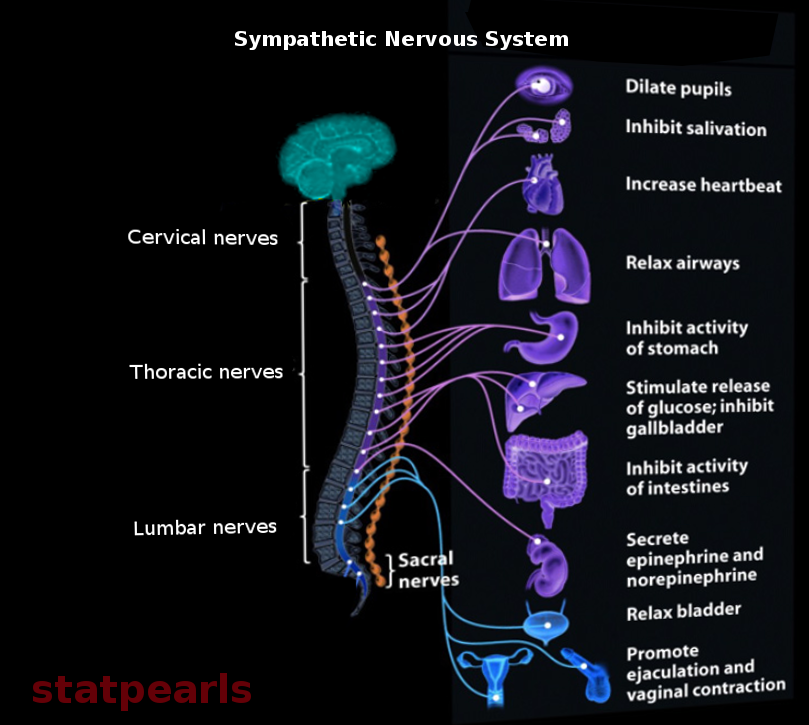[1]
McCorry LK. Physiology of the autonomic nervous system. American journal of pharmaceutical education. 2007 Aug 15:71(4):78
[PubMed PMID: 17786266]
[2]
Wehrwein EA,Orer HS,Barman SM, Overview of the Anatomy, Physiology, and Pharmacology of the Autonomic Nervous System. Comprehensive Physiology. 2016 Jun 13;
[PubMed PMID: 27347892]
Level 3 (low-level) evidence
[3]
Shibasaki M, Crandall CG. Mechanisms and controllers of eccrine sweating in humans. Frontiers in bioscience (Scholar edition). 2010 Jan 1:2(2):685-96
[PubMed PMID: 20036977]
[4]
Strosberg AD. Structure, function, and regulation of adrenergic receptors. Protein science : a publication of the Protein Society. 1993 Aug:2(8):1198-209
[PubMed PMID: 8401205]
[5]
Young HM, Cane KN, Anderson CR. Development of the autonomic nervous system: a comparative view. Autonomic neuroscience : basic & clinical. 2011 Nov 16:165(1):10-27. doi: 10.1016/j.autneu.2010.03.002. Epub 2010 Mar 25
[PubMed PMID: 20346736]
Level 2 (mid-level) evidence
[6]
Pfeifer MA, Weinberg CR, Cook D, Best JD, Reenan A, Halter JB. Differential changes of autonomic nervous system function with age in man. The American journal of medicine. 1983 Aug:75(2):249-58
[PubMed PMID: 6881176]
[7]
Shimazu T, Tamura N, Shimazu K. [Aging of the autonomic nervous system]. Nihon rinsho. Japanese journal of clinical medicine. 2005 Jun:63(6):973-7
[PubMed PMID: 15948378]
[8]
Esler M, Hastings J, Lambert G, Kaye D, Jennings G, Seals DR. The influence of aging on the human sympathetic nervous system and brain norepinephrine turnover. American journal of physiology. Regulatory, integrative and comparative physiology. 2002 Mar:282(3):R909-16
[PubMed PMID: 11832414]
Level 2 (mid-level) evidence
[9]
González-Aguado R, Morales-Angulo C, Obeso-Agüera S, Longarela-Herrero Y, García-Zornoza R, Acle Cervera L. Horner's syndrome after neck surgery. Acta otorrinolaringologica espanola. 2012 Jul-Aug:63(4):299-302
[PubMed PMID: 22502736]
[10]
Hu X, Zhang X, Gan H, Yu D, Sun W, Shi Z. Horner syndrome as a postoperative complication after minimally invasive video-assisted thyroidectomy: A case report. Medicine. 2017 Dec:96(48):e8888. doi: 10.1097/MD.0000000000008888. Epub
[PubMed PMID: 29310374]
Level 3 (low-level) evidence
[12]
Vannucci F, Araújo JA. Thoracic sympathectomy for hyperhidrosis: from surgical indications to clinical results. Journal of thoracic disease. 2017 Apr:9(Suppl 3):S178-S192. doi: 10.21037/jtd.2017.04.04. Epub
[PubMed PMID: 28446983]
[13]
Thune TH, Ladegaard L, Licht PB. Thoracoscopic sympathectomy for Raynaud's phenomenon--a long term follow-up study. European journal of vascular and endovascular surgery : the official journal of the European Society for Vascular Surgery. 2006 Aug:32(2):198-202
[PubMed PMID: 16564187]
[15]
Halls JE, Patel DV, Walkden M, Patel U. Priapism: pathophysiology and the role of the radiologist. The British journal of radiology. 2012 Nov:85 Spec No 1(Spec Iss 1):S79-85. doi: 10.1259/bjr/62360925. Epub 2012 Sep 6
[PubMed PMID: 22960245]
[16]
Alwaal A,Breyer BN,Lue TF, Normal male sexual function: emphasis on orgasm and ejaculation. Fertility and sterility. 2015 Nov;
[PubMed PMID: 26385403]
[17]
Freccero C, Svensson H, Bornmyr S, Wollmer P, Sundkvist G. Sympathetic and parasympathetic neuropathy are frequent in both type 1 and type 2 diabetic patients. Diabetes care. 2004 Dec:27(12):2936-41
[PubMed PMID: 15562210]
[18]
Verrotti A, Prezioso G, Scattoni R, Chiarelli F. Autonomic neuropathy in diabetes mellitus. Frontiers in endocrinology. 2014:5():205. doi: 10.3389/fendo.2014.00205. Epub 2014 Dec 1
[PubMed PMID: 25520703]
[19]
Freeman R, Wieling W, Axelrod FB, Benditt DG, Benarroch E, Biaggioni I, Cheshire WP, Chelimsky T, Cortelli P, Gibbons CH, Goldstein DS, Hainsworth R, Hilz MJ, Jacob G, Kaufmann H, Jordan J, Lipsitz LA, Levine BD, Low PA, Mathias C, Raj SR, Robertson D, Sandroni P, Schatz I, Schondorff R, Stewart JM, van Dijk JG. Consensus statement on the definition of orthostatic hypotension, neurally mediated syncope and the postural tachycardia syndrome. Clinical autonomic research : official journal of the Clinical Autonomic Research Society. 2011 Apr:21(2):69-72. doi: 10.1007/s10286-011-0119-5. Epub
[PubMed PMID: 21431947]
Level 3 (low-level) evidence
[20]
Metzler M, Duerr S, Granata R, Krismer F, Robertson D, Wenning GK. Neurogenic orthostatic hypotension: pathophysiology, evaluation, and management. Journal of neurology. 2013 Sep:260(9):2212-9. doi: 10.1007/s00415-012-6736-7. Epub 2012 Nov 20
[PubMed PMID: 23180176]

